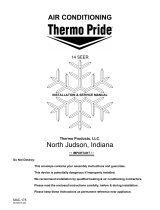
7
REFRIGERANT CHARGING
WARNING:
*SA(1,2)BD4M Split System Air Conditioners
are shipped charged with R410A refrigerant
and ready for installation. If repairs make it
necessary for evacuation and charging, it should
only be attempted by qualified trained personnel
thoroughly familiar with this equipment. Under
no circumstances should the owner attempt to
install and/or service this equipment. Failure to
comply with this warning could result in property
damage, personal injury, or death.
After refrigerant line connections are completed, it is required
that you leak check and evacuate the indoor section and all
line connections (using proper methods) before finalizing the
full system refrigerant charge.
• *SA(1,2)BD4M outdoor units with non-AHRI listed indoor
coils are not recommended. Deviations from rated airflows
or non-listed combinations may require modification to the
expansion device and refrigerant charging procedures for
proper and efficient system operation.
• The refrigerant charge can be checked and adjusted through
the service ports provided external to the outdoor unit. Use
only gage line sets which have a “Schrader” depression
device present to actuate the valve.
• A high-pressure switch is factory-installed and located in
the liquid line internal to the outdoor unit. The switch is
designed to protect the system when very high pressures
occur during abnormal conditions. Under normal conditions,
the switch is closed. If the liquid pressure rises above 575
psig, then the switch will open and de-energize the outdoor
unit. The switch will close again once the liquid pressure
decreases to 460 psig. Please note that the switch interrupts
the thermostat inputs to the unit. Thus, when the switch
opens and then closes, there may be a 5 minute short
cycling delay before the outdoor unit will energize.
• A low-pressure switch (Select Models) is factory-installed
and located in the suction line internal to the outdoor unit.
The switch is designed to protect the compressor from
a loss of charge. Under normal conditions, the switch is
closed. If the suction pressure falls below 5 psig, then the
switch will open and de-energize the outdoor unit. The
switch will close again once the suction pressure increases
above 20 psig. Please note that the switch interrupts the
thermostat inputs to the unit. When the switch opens and
then closes, there will be a 5 minute short cycling delay
before the outdoor unit will energize.
START UP & ADJUSTMENTS
Pre-Start Check List
√ Verify the indoor unit is level and allows proper condensate
drainage.
√ Verify the outdoor coil and top of the unit are free from
obstructions and debris, and all equipment access/control
panels are in place.
√ Verify air filters are cleaned and properly installed.
√ Verify duct work is sealed to prevent air leakage.
√ Verify line voltage power leads are securely connected
and the unit is properly grounded.
√ Verify low voltage wires are securely connected to the
correct leads on the low voltage terminal strip.
√ Verify power supply branch circuit overcurrent protection
is sized properly.
√ Verify the thermostat is wired correctly.
Start-Up Procedures
The thermostat's function mode should be set to OFF and
the fan mode should be set to AUTO. Close all electrical
disconnects to energize the system.
Air Circulation - Indoor Blower
1. Set the thermostat system mode on OFF and the fan mode
to ON.
2. Verify the blower runs continuously. Check the air delivery
at the supply registers and adjust register openings for
balanced air distribution. If insufficient air is detected,
examine ductwork for leaks or obstructions.
3. Set the thermostat fan mode to AUTO and verify the blower
stops running.
System Cooling
1. Set the thermostat’s system mode to COOL and the fan
mode to AUTO. Gradually lower the thermostat temperature
setpoint below room temperature and verify the outdoor
unit and indoor blower energize.
2. Verify blower wheel is spinning in direction indicated by
arrow. Feel the air being circulated by the indoor blower
and verify that it is cooler than ambient temperature. Listen
for any unusual noises. If unusual sounds occur, determine
the source of the noise and correct as necessary.
3. Verify HI and LO refrigerant pressures.
4. Allow the system to operate for several minutes and then
set the temperature selector above room temperature.
Verify the fan and compressor cycle off with the thermostat.
NOTE: The blower should also stop unless fan mode is
set to the ON position.
System Heating (optional)
1. Set the thermostat's system mode to HEAT and the
temperature mode above room temperature.
2. Verify the optional heating equipment (furnace or electric
heat) and indoor blower energize. Feel the air being
circulated by the indoor blower and verify that it is warmer
than ambient temperature. Listen for any unusual noises.
If unusual sounds occur, determine the source of the noise
and correct as necessary.
















